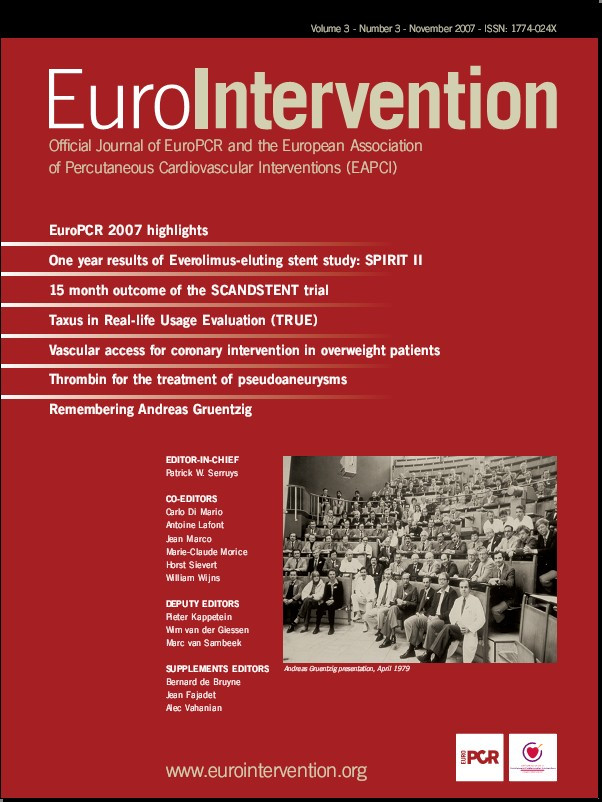Abstract
Aims: There is uncertainty on the clinical outcomes of percutaneous coronary intervention (PCI) in patients with left ventricular dysfunction (LVD). We thus performed a systematic review of studies reporting on PCI in LVD.
Methods and results: Pertinent studies were searched in PubMed, and included if reporting on ≥30 patients, with ejection fraction < 50%, and prevalently (>60%) treated with stents. The primary endpoint was the occurrence of major adverse cardiovascular events (MACE) at the longest follow-up. Outcomes were pooled with random-effect methods (95% confidence intervals). We retrieved 11 studies including 1,284 patients with ejection fraction <50% (specifically <40% in 1,033 and <30% in 211). All studies but one reported on bare-metal stenting only. In-hospital MACE occurred in 5% (3-6), with death in 2% (1-3), myocardial infarction in 3% (2-4), and repeat revascularisation in 1% (0-2). After a median of 18 months, MACE occurred in 33% (30-36), with death in 11% (9-13), myocardial infarction in 7% (6-9), and repeat revascularisation in 15% (13-18). Meta-regression suggested the beneficial impact of drug-eluting stents on MACE (p=0.030).
Conclusions: Currently available data support the adoption of percutaneous revascularisation in carefully selected patients with LVD. While event attrition remains substantial at long-term follow-up, drug-eluting stents hold the promise of significantly improving event-free and overall survival.
Introduction
Patients with depressed left ventricular systolic function and concomitant coronary artery disease are a very high-risk population.1 Coronary revascularisation may be indicated in such patients whenever anginal symptoms, clinical signs or imaging tests suggest viability and the opportunity for improvement of cardiac function.2 However, for these very reasons, subjects with left ventricular dysfunction face major increases in peri-procedural and long-term event rates after coronary revascularisation.3
Coronary artery bypass grafting has been considered to date the standard treatment for coronary artery disease in patients with left ventricular dysfunction.4 Since its introduction in clinical practice, percutaneous transluminal coronary angioplasty has also been employed in selected patients with such characteristics, albeit with limited results.3,5-6 This can be easily explained by the fact that drawbacks of balloon-only coronary intervention (vessel recoil, need for prolonged inflations in case of suboptimal results, dissection, or abrupt closure, and high restenosis rate at follow-up), may lead to ominous adverse events in subjects with low ejection fraction and a large area of jeopardised myocardium.
The introduction of coronary stents have markedly improved results of percutaneous coronary intervention in general,7 and a number of reports of coronary stenting in patients with depressed left ventricular function have already been reported, albeit with conflicting results.8-10 We thus aimed to perform an updated and comprehensive systematic review and meta-analysis of studies reporting on coronary stenting in patients with depressed (<50%) left ventricular ejection fraction.
Methods
Search strategy
Pertinent studies were searched in PubMed (updated April 2007) according to a detailed search strategy (see Appendix for the detailed string). In addition, we checked references of retrieved studies (backward snowballing) and cross-references (forward snowballing).
Study selection
Preliminary retrieved citations were checked at the title/abstract level, and then collected as complete reports if potentially pertinent in order to be appraised according to the following inclusion and exclusion criteria. Inclusion criteria were: studies reporting on a) > 30 patients, b) with ejection fraction <50%, and c) prevalently (>60%) treated with stents. We excluded studies reporting solely on patients with a) acute or recent (<4 weeks) myocardial infarction, b) unprotected left main intervention, or c) published only as abstracts.
Data abstraction
The primary endpoint was the occurrence of major adverse cardiovascular events (MACE), defined as the composite of death, non-fatal myocardial infarction (either Q-wave or non-Q-wave), or repeat target vessel revascularisation (TVR), at the longest follow-up available (with ≥90% completion). Secondary endpoints included the other individual components of MACE: in-hospital all cause death, in-hospital myocardial infarction, all cause death at follow-up, myocardial infarction at follow-up, and TVR at follow-up. Other details on patients, procedures, and study designs were abstracted, including pertinent statistics for age, left ventricular ejection fraction, proportion of male gender, diabetes mellitus, previous myocardial infarction, and previous bypass surgery.
Internal validity and quality appraisal
The quality of included studies was appraised by separately estimating the risk of selection, performance, detection and attrition bias (expressed as low risk of bias [A], moderate risk of bias [B], high risk of bias [C], or incomplete reporting leading to inability to ascertain the underlying risk of bias [D]), and abstracting additional design features.
Data analysis and synthesis
Continuous variables are reported as mean (standard deviation) or median (range), when appropriate. Categorical variables are expressed as n/N (%). Statistical pooling for non-controlled studies was performed according to a random effect model and computing incidence estimates (with 95% confidence intervals). Meta-regression was performed to appraise the impact of moderator variables on in-hospital and follow-up events, by means of weighted least squares linear regression,11,12 using either the crude event rate or the log10 transformed event rate as dependent variable, the variable of interest as independent variable, and sample size as weight (SPSS 11.0, SPSS, Chicago, IL, USA). Statistical inconsistency was appraised by I2. Unadjusted p values are reported throughout, with hypothesis testing set at the two-tailed 0.05 level. Given the design of this study, formal ethical approval was waived.
Results
Systematic searches retrieved a total of 869 citations (Figure 1), from which 843 were discarded at the title/abstract level and 15 after appraisal of complete manuscripts, thus leaving 11 studies for inclusion in the systematic review (Tables 2-4).8-10,13-20
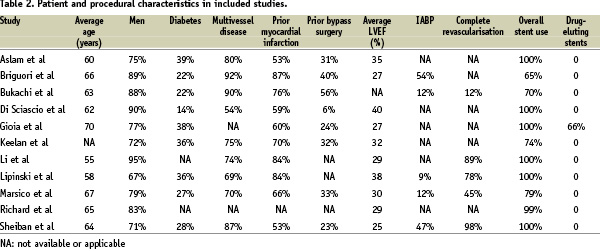
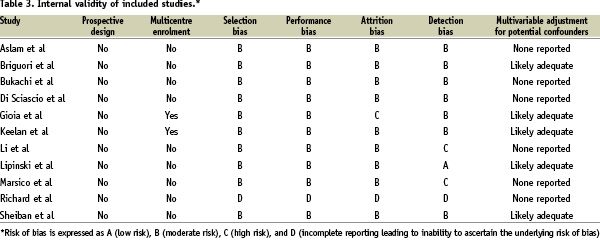
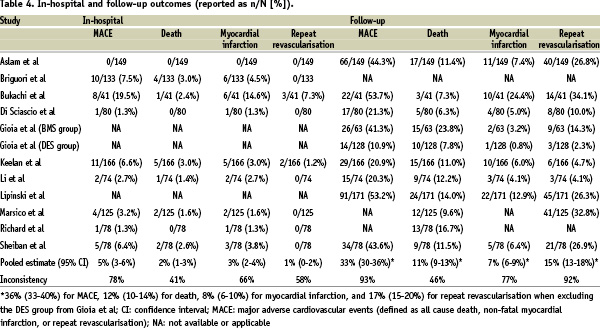
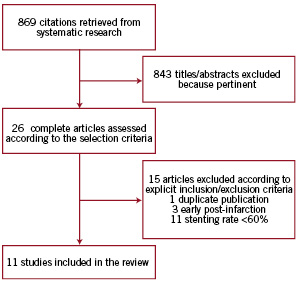
Figure 1. Flow profile of the systematic reviewing process.
Specifically, we excluded 15 studies, including the pivotal AWESOME trial, the BARI study, and the NHLBI PTCA Registry, because of stenting rate <60%,1,3-6,21-26 three studies were discarded because focusing solely on the early post-infarction period;27-29 and one study was excluded because of duplicate reporting.30
Main features of included studies
The 11 included studies enrolled a total of 1,284 patients, and were published between 2000 and 2007 (Tables 1-4).
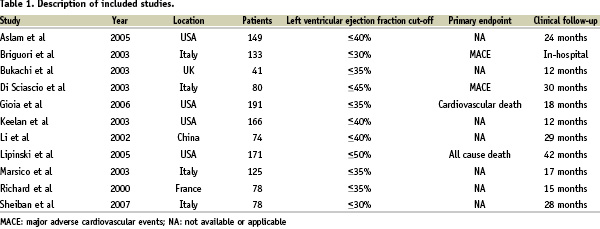
While all studies reported on patients having a baseline left ventricular ejection fraction <50%, two of them used a 45-50% cut-off,8,16 three used a 40% cut-off,15,18,20 and four a 35% cut-off,9,10,13,19 but only two reports (211 patients) focused on the very high-risk subset of subjects with ejection fraction <30%.14,17 Means to appraise left ventricular function included contrast ventriculography, echocardiography and nuclear scintigraphy, but were not uniformly reported in detail. Most patients were treated on elective basis, intra-aortic balloon pump was used in a median of 12%, stent usage per patient ranged from 65% to 100%, will all studies but one19 employing only bare-metal stents. Follow-up ranged from in-hospital to 42 months, with a median of 18 months.
Meta-analysis and meta-regression
Individual and pooled event rates are detailed in Table 4 and summarised in Figures 2-3.
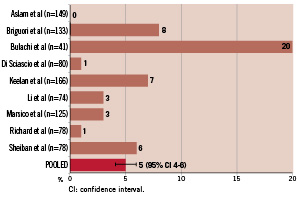
Figure 2. Individual and random-effect pooled estimates of the risk of major adverse cardiovascular events at hospital discharge.
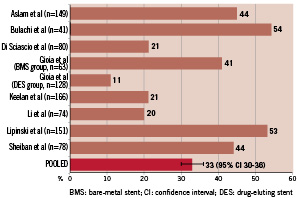
Figure 3. Individual and random-effect pooled estimates of the risk of major adverse cardiovascular events at follow-up (median 18 months).
Specifically, random-effect pooled rates of in-hospital MACE were 5% (3-6%), with death in 2% (1-3%), myocardial infarction in 3% (2-4%), and repeat revascularisation in 1% (0-2%). At follow-up, pooled rates of MACE were in 33% (30-36%), with death in 11% (9-13%), myocardial infarction in 7% (6-9%), and repeat revascularisation in 15% (13-18%).
Meta-regression, albeit underpowered due to the small total number of included studies and variable criteria for patient selection, showed a non-significant trend toward increased events in patients with lower ejection fraction (p=0.09). In addition, use of IABP was also associated with an evident trend toward increased in-hospital or follow-up adverse events (p=0.06). Finally, interaction for drug-eluting stent use was statistically significant for both MACE and all cause death at long-term follow-up (respectively p=0.030 and p=0.048) in favour of this type of devices, but this finding should be viewed in light of the reliance on a single study.19
Discussion
The present meta-analysis, pooling for the first time to date studies on percutaneous coronary intervention in patients with left ventricular dysfunction and including 1,284 subjects, has the following implications: a) pooled in-hospital event rates prove that percutaneous revascularisation can be safely performed in selected patients with systolic dysfunction, yielding a low risk of peri-procedural morbidity and mortality; b) event rates increase markedly over follow-up, as can be expected in such a high-risk patient population, but the benefits of achieving revascularisation and improving even modestly a depressed cardiac function should not be dismissed; c) promising data from a single study support the use of drug-eluting stents in order to improve event-free and overall survival, even if concerns about stent thrombosis, indeed more common with depressed systolic function,31 should be borne in mind.
Since its infancy, percutaneous transluminal coronary angioplasty has been applied in high-risk subjects and lesions, as testified by the attempt to treat percutaneously an unprotected left main stenosis by the late Andreas Gruentzig.32 Early and late results were however limited by the inherent drawbacks of balloon-only interventions. The introduction of coronary stents and potent oral and intravenous antiplatelet therapies have later resulted in marked improvements in procedural and long-term results of coronary revascularisation.7 Indeed, the greatest improvements have been seen in high-risk patients and more complex procedures, such that nowadays percutaneous revascularisation is considered the first line treatment in high-risk patients with acute coronary syndromes.2
Patients with severe left ventricular dysfunction have conversely remained a subset of patients that are rarely treated percutaneously. Moreover, given the substantial operative risk whenever systolic function is severely reduced, even cardiac bypass surgery is performed less frequently than indicated in such patients.4 This has amounted to date to a missed opportunity, as medical treatment only for patients with severe left ventricular function and coronary artery disease is associated with an ominous prognosis, despite major recent developments.33
Notwithstanding the exclusion of some pivotal studies focusing on balloon-only interventions, such as the BARI trial,1 the AWESOME Study,21 and others,22-24 the present review provides a comprehensive and updated synthesis on the procedural and long-term outlook of patients with significant left ventricular dysfunction undergoing percutaneous coronary stenting. Indeed, in most studies percutaneous revascularisation could be safely accomplished, with in-hospital mortality rates as low as 018 and as high as 3%.15-17 Results after discharge were conversely only relatively favourable, given the substantial MACE rate averaging 33% (but as high as 54% in Bukachi et al).9 However, this should be viewed in light of the high risk features at baseline and of the fact that most adverse events consisted in repeat percutaneous revascularisation. In this context, notwithstanding the potential for late thrombosis in subjects with depressed left ventricular function,31 drug-eluting stents may provide substantial clinical benefits in such patients.19 Of interest, intra-aortic balloon pump was used selectively and likely only in very complex patients. While this reflects worldwide practice patterns, some authorities have advocated a more liberal use of this device in patients with depressed left ventricular ejection fraction undergoing percutaneous coronary intervention.17 In addition, other means to provide haemodynamic support in this setting have been proposed and preliminarily tested (e.g.; cardiopulmonary support, TandemHeart, or Impella), even if definitive proof of efficacy lacks for most of these devices.
The importance of peri-procedural antithrombotic therapy cannot be overemphasised, as aspirin, clopidogrel, and glycoprotein IIb/IIIa inhibitors should be concomitantly administered in most if not all patients, especially if recovering from a recent acute coronary syndrome.11,12 Finally, another issue worth considering in patients with multivessel coronary disease and left ventricular dysfunction is the importance of achieving a complete revascularisation.34,35 Indeed, if complete revascularisation can be safely achieved, this should be the preferred strategy. However, as testified by studies included in this review, this remains a challenging goal in many patients, especially if completeness of revascularisation is defined on a anatomical basis instead than on a functional basis.36
Study limitations
This work has several limitations beyond those typical of systematic reviews of observational studies. Specifically, data reporting was not complete for all baseline, procedural and outcome data, and studies often differed in cut-off used to define systolic dysfunction and length of clinical follow-up. In addition, we could not compare results of percutaneous coronary intervention to medical therapy which could also be considered appropriate in the absence of anginal symptoms or viability, or with bypass surgery, which may be more appropriate according to specific patient or anatomic features.37,38 Finally, the major limitation of this meta-analysis lies in the reliance of small studies included highly selected patients undergoing percutaneous revascularisation at high-volume and expertise centres. Thus, these results should be viewed with caution and not uncritically applied to all patients with coronary artery disease and depressed left ventricular fraction.
Conclusions
Currently available data support the adoption of percutaneous revascularisation in carefully selected patients with significant left ventricular systolic dysfunction. While event attrition remains substantial at long-term follow-up, drug-eluting stents hold the promise of significantly improving event-free and overall survival.
Appendix
PubMed was searched with the following strategy: ((left AND ventricular) OR lv) AND (dysfunction OR (depressed AND function)) AND (ptca[mh] OR stent[mh] OR stent*) AND coronary NOT review[pt] NOT editorial[pt] AND (hasabstract[text]) AND (English[lang]) AND (adult[MeSH]) AND (Humans[Mesh])
FUNDING: None
Acknowledgements
This study is part of an ongoing senior investigator program of the Centre for Overview, Meta-analysis, and Evidence-based medicine Training (COMET) based in Turin, Italy (http://www.comet.gs).
